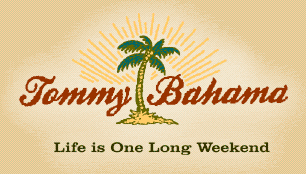
Life’s a beach sometimes.
Tommy Bahama isn’t just a clothing line. It’s a lifestyle. Catching the big one off the deck of a schooner bound for Tahiti, sipping a tall cool one at a beach bar in Barbados, or dancing the night away under the stars to a Jamaican reggae band.
 The image is so well ingrained – the swaying palms and tropical sun – that it’s hard to imagine Tommy Bahama ever putting its tropical roots in Washington. Yet that’s exactly where this beach fashion icon was founded more than 20 years ago.
The image is so well ingrained – the swaying palms and tropical sun – that it’s hard to imagine Tommy Bahama ever putting its tropical roots in Washington. Yet that’s exactly where this beach fashion icon was founded more than 20 years ago.
Like most stories involving business legends, Tommy Bahama started off as something of a lark. Bob Emfield and Tony Margolis were vacationing in Florida in the 1980s. As their vacation drew to a close, Bob, Tony and their wives joked about how they never wanted to leave this life of leisure on the shores of the Gulf of Mexico.
Their dreams of life at the beach took on a life of its own – Tommy Bahama. As the couples talked, they created a rich storyline of a mythical jet-setting bon vivant; how he lived, how he passed his time, where he lived and what he owned.
Eventually, Bob and Tony happened upon the question that would go on to launch a company: “What does Tommy Bahama wear?” The question was inevitable, given that both men had worked at Generra Sportswear and Britannia when the clothing companies were at their height of success.
In 1991, the two finally decided to bring Tommy Bahama to life, creating an upscale tropical clothing line appealing to men over 35. To help them shape the brand, they tapped the talent of Lucio Dalla Gasperina, a Union Bay sportswear alumnus who came aboard as the label’s design guru.
With $2 million in capital Tommy Bahama was born. Retailers hardly beat a path to his door, however. Mistakes were made early on, including a consumer base that was too broad, huge executive salaries and lavish lifestyles that even Tommy would envy, and a distribution strategy that was ill defined and poorly executed at best.
But business legends, certainly the ones built in Washington State, don’t cower when it comes to such things as poor cash flow or questionable distribution. When major retailers turned a deaf ear, Tommy Bahama went the specialty route, targeting smaller chains instead. It was an expensive strategy, one that didn’t have any promise of a short-term return. Long term, however, it was a brilliant strategy. Smaller retailers became very loyal to the brand, convincing their customers that the Tommy Bahama clothing line was worth the investment, not only in terms of dollars but in terms of making a bold fashion statement.
Taking the road less traveled seems to be another hallmark of business legends. Faced with the need to do marketing, Tommy Bahama turned its back on traditional advertising strategies, eschewing commercials in favor of a restaurant.
Yes, a restaurant. The first Tommy Bahamas restaurant opened in Naples, Florida in 1996. The concept was to create a place where Tommy would love to hang out. Customers loved the concept, so much so that they bought more than $2 million of merchandise in the neighboring store in the first year, easily covering the cost of construction. Today there are 15 Tommy Bahama restaurants around the world.
The company has expanded into other areas as well. Tommy Bahama has a line of denim jeans, sportswear, swimwear, footwear, furnishings and even rum. The brand can be found in such blue-chip retailers as Macy’s, Nieman Marcus, Sak’s Fifth Avenue and Nordstrom as well as in 80 company-owned stores and outlets throughout the U.S.
Tommy Bahama is indeed living the good life these days. Company net sales volume is north of $1 billion with an impressive growth rate in double digits. All because of three men from Washington State, some vivid imaginations and a globetrotting, beachcombing friend by the name of Tommy Bahama.
Learn more about Tommy Bahama.